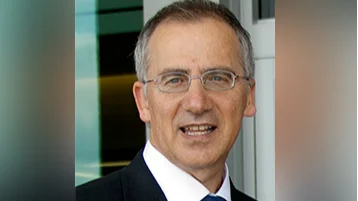
Mijali Munoz Proestakis, a 56-year-old engineer and adventure sports enthusiast, has returned to aerobatic flying after undergoing specialized brain surgery at UTHealth Houston. Proestakis, who led the drilling operation that rescued 33 Chilean miners in 2010, suffered a stroke in July 2024 while in Santiago, Chile.
After being diagnosed with an ischemic stroke and undergoing heart surgery for a patent foramen ovale (PFO), Proestakis continued to experience neck pain. Seeking further evaluation, he traveled to Houston where a team from the Department of Neurology at McGovern Medical School at UTHealth Houston discovered he had a fusiform aneurysm on one of the posterior inferior cerebellar arteries (PICA) at the base of his brain.
Due to the aneurysm’s shape and location, traditional treatments such as clipping or stenting were not viable options. Proestakis was referred to Jacques J. Morcos, MD, professor and chair of the Vivian L. Smith Department of Neurosurgery and co-director of UTHealth Houston Neurosciences. Dr. Morcos specializes in complex cerebrovascular procedures.
“If we had not treated it, the aneurysm could have ruptured into a full-blown subarachnoid hemorrhage, or it could have kept ballooning, showering off emboli and causing a stroke in the cerebellum. That is what he had on the first event,” Morcos said. “The alternative to surgery could have been to try and place a stent, but the location of the aneurysm ruled this out, as it would have either failed or caused closure of the artery and a stroke.”
Morcos performed a PICA-PICA side-to-side bypass along with trapping of the aneurysm—an uncommon procedure that involves connecting two arteries with very fine sutures before isolating the aneurysm.
“Those two arteries come close to each other in the posterior part of the brain. I connect them together with very small sutures. The thread is so small, you would have to bundle 50 of them to reach the size of a human hair. After creating the connection left-right, I can trap off the aneurysm and cure it. The blood flow is taken over from the other side,” Morcos said. “Of all the aneurysm surgeries we do, only 1% are done in this way.”
Proestakis expressed confidence in his surgical team after researching Morcos’ background and discussing his desire to return safely to flying.
“As an engineer, what he was telling me made sense,” Proestakis said. “It was amazing watching the process and how professional they were. I had an angiogram right before surgery and another one right after surgery to make sure there were no leaks. You could see the team work and the energy flow. I told both my daughters to not worry – I would be at their weddings because I was with the best guy in the world.”
Following his November 2024 surgery at UTHealth Houston, Proestakis recovered quickly—walking within a day and leaving hospital care four days later.
“He did super well,” Morcos said. “His balance is perfect, and that is key because the aneurysm was in the area of the cerebellum that has to do with balance. He is able to do the sports he enjoys. Most importantly, he is completely cured from his aneurysm and has returned to all activities.”
Six months post-surgery, Proestakis resumed flying aerobatics with another pilot onboard; recently he regained clearance for solo flights.
“I was, and am, supported by a great medical team, and I was really lucky to find them,” Proestakis said. “I want to thank them for letting me get back to life and flying with the same lifestyle I had before the stroke.”
He plans on participating in an air show in Chile next year using his newly purchased plane.